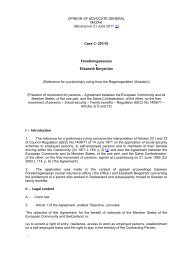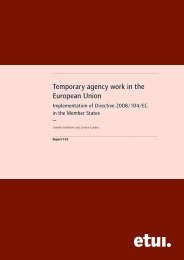Study on non-legislative initiatives for companies to promote gender ...
Study on non-legislative initiatives for companies to promote gender ...
Study on non-legislative initiatives for companies to promote gender ...
You also want an ePaper? Increase the reach of your titles
YUMPU automatically turns print PDFs into web optimized ePapers that Google loves.
Gender equality <strong>initiatives</strong> 123<br />
Initiatives also address different groups of enterprises:<br />
• All employers: Initiatives with a broad scope mostly address all types of<br />
employers including <strong>companies</strong>, public organisati<strong>on</strong>s and NGOs. As these<br />
organisati<strong>on</strong>s act under different framework c<strong>on</strong>diti<strong>on</strong>s they are not directly<br />
comparable, so often different subgroups are created. Mainly prizes are<br />
awarded in different categories (in some cases the names of the prizes even<br />
differ), e.g. separately <strong>for</strong> public organisati<strong>on</strong>s and enterprises, private enterprises<br />
and NGO or third sec<strong>to</strong>r organisati<strong>on</strong>s such as social enterprises. Am<strong>on</strong>g<br />
private enterprises there is often an additi<strong>on</strong>al distincti<strong>on</strong> with regard <strong>to</strong> firm size<br />
(see below). Moreover, the inclusi<strong>on</strong> of all types of employers is often a way <strong>to</strong><br />
foster networking and co-operati<strong>on</strong> am<strong>on</strong>g the key players <strong>on</strong> the labour market.<br />
• Private enterprises: As public organisati<strong>on</strong>s are often subject <strong>to</strong> a more<br />
stringent legislati<strong>on</strong> as regards quotas, equality requirements etc. many <strong>initiatives</strong><br />
c<strong>on</strong>centrate their ef<strong>for</strong>ts <strong>on</strong> the private sec<strong>to</strong>r and target at private<br />
employers where <strong>gender</strong> equality <strong>initiatives</strong> are more often the result of<br />
voluntary acti<strong>on</strong>s than of legal requirements. These private enterprises are often<br />
divided in<strong>to</strong> subgroups following size criteria. This makes possible adapting the<br />
requirements <strong>for</strong> participati<strong>on</strong> as e.g. SMEs will not be able <strong>to</strong> present a <strong>gender</strong><br />
equality plan covering as much areas as a large enterprise. Some <strong>initiatives</strong><br />
also limit their target group <strong>to</strong> enterprises of a specific minimum size. This is the<br />
case <strong>for</strong> <strong>initiatives</strong> which focus e.g. <strong>on</strong> the vertical segregati<strong>on</strong> which are mainly<br />
relevant <strong>for</strong> larger enterprises.<br />
• Enterprises active in specific sec<strong>to</strong>rs: Initiatives targeting at the horiz<strong>on</strong>tal<br />
segregati<strong>on</strong> often focus their activities <strong>on</strong> enterprises active in male-dominated<br />
sec<strong>to</strong>rs, such as technical- and technological-oriented industries or enterprises<br />
active in research activities.<br />
The different aims and target groups cannot easily be associated <strong>to</strong> a specific type of<br />
initiative. Nevertheless, slight differences between the types of <strong>initiatives</strong> can be<br />
identified in terms of the target groups and other characteristics such as the applicati<strong>on</strong><br />
process, the assessment criteria and procedure as well as the degree of commitment a<br />
participating enterprise is bound <strong>to</strong>.<br />
Thus, rankings mainly assess large enterprises and also charters are more likely <strong>to</strong> be<br />
signed by large organisati<strong>on</strong>s. As far as charters are c<strong>on</strong>cerned, beside the private<br />
sec<strong>to</strong>r many public authorities and NGOs tend <strong>to</strong> join. On the c<strong>on</strong>trary, labels and<br />
prizes more often address all types of enterprises. To guarantee a fair competiti<strong>on</strong><br />
and <strong>to</strong> motivate SMEs and public or third sec<strong>to</strong>r organisati<strong>on</strong>s <strong>to</strong> participate, different<br />
prizes in different categories are awarded and the requirements (and/or fees) <strong>for</strong><br />
smaller enterprises are reduced.<br />
C<strong>on</strong>cerning the applicati<strong>on</strong> process, enterprises apply <strong>for</strong> participating in a label or an<br />
award, whereas in the case of charters enterprises are often already involved in<br />
<strong>for</strong>mulating and launching the charter or even initiate it. A ranking based <strong>on</strong> an external<br />
evaluati<strong>on</strong> knows no applicati<strong>on</strong> or just a registrati<strong>on</strong> of the enterprise. For the inclusi<strong>on</strong><br />
in a compendium of good practice enterprises are asked <strong>to</strong> provide in<strong>for</strong>mati<strong>on</strong>.
















